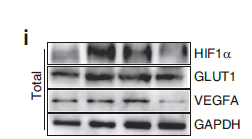
主要信息
Target
Hexb
Host Species
Rabbit
Reactivity
Human, Rat, Mouse,
Applications
WB, IHC, IF, ELISA
MW
63kD (Observed)
Conjugate/Modification
Unmodified
货号: YT2128
规格
价格
货期
数量
200μL
¥3,780.00
现货
0
100μL
¥2,300.00
现货
0
40μL
¥960.00
现货
0
加入购物车


已收藏


收藏
详细信息
推荐稀释比
WB 1:500-1:2000; IHC 1:100-1:300; IF 1:200-1:1000; ELISA 1:20000; Not yet tested in other applications.
组成
Liquid in PBS containing 50% glycerol, 0.5% BSA and 0.02% sodium azide.
特异性
Hexb Polyclonal Antibody detects endogenous levels of Hexb protein.
纯化工艺
The antibody was affinity-purified from rabbit antiserum by affinity-chromatography using epitope-specific immunogen.
储存
-15°C to -25°C/1 year(Do not lower than -25°C)
浓度
1 mg/ml
实测条带
63kD
修饰
Unmodified
克隆性
Polyclonal
同种型
IgG
相关产品
抗原&靶点信息
免疫原:
The antiserum was produced against synthesized peptide derived from human HEXB. AA range:481-530
展开内容
特异性:
Hexb Polyclonal Antibody detects endogenous levels of Hexb protein.
展开内容
基因名称:
HEXB
展开内容
蛋白名称:
Beta-hexosaminidase subunit beta
展开内容
别名:
HEXB ;
HCC7 ;
Beta-hexosaminidase subunit beta ;
Beta-N-acetylhexosaminidase subunit beta ;
Hexosaminidase subunit B ;
Cervical cancer proto-oncogene 7 protein ;
HCC-7 ;
N-acetyl-beta-glucosaminidase subunit beta
HCC7 ;
Beta-hexosaminidase subunit beta ;
Beta-N-acetylhexosaminidase subunit beta ;
Hexosaminidase subunit B ;
Cervical cancer proto-oncogene 7 protein ;
HCC-7 ;
N-acetyl-beta-glucosaminidase subunit beta
展开内容
背景:
Hexosaminidase B is the beta subunit of the lysosomal enzyme beta-hexosaminidase that, together with the cofactor GM2 activator protein, catalyzes the degradation of the ganglioside GM2, and other molecules containing terminal N-acetyl hexosamines. Beta-hexosaminidase is composed of two subunits, alpha and beta, which are encoded by separate genes. Both beta-hexosaminidase alpha and beta subunits are members of family 20 of glycosyl hydrolases. Mutations in the alpha or beta subunit genes lead to an accumulation of GM2 ganglioside in neurons and neurodegenerative disorders termed the GM2 gangliosidoses. Beta subunit gene mutations lead to Sandhoff disease (GM2-gangliosidosis type II). Alternatively spliced transcript variants encoding different isoforms have been found for this gene. [provided by RefSeq, May 2014],
展开内容
功能:
Catalytic activity:Hydrolysis of terminal non-reducing N-acetyl-D-hexosamine residues in N-acetyl-beta-D-hexosaminides.,Disease:Defects in HEXB are the cause of GM2-gangliosidosis type 2 (GM2G2) [MIM:268800]; also known as Sandhoff disease. GM2-gangliosidosis is an autosomal recessive lysosomal storage disease marked by the accumulation of GM2 gangliosides in the neuronal cells. GM2G2 is clinically indistinguishable from GM2-gangliosidosis type 1, presenting startle reactions, early blindness, progressive motor and mental deterioration, macrocephaly and cherry-red spots on the macula.,Function:Responsible for the degradation of GM2 gangliosides, and a variety of other molecules containing terminal N-acetyl hexosamines, in the brain and other tissues.,online information:HEXB mutation database,PTM:N-linked glycans at Asn-142 and Asn-190 consist of Man(3)-GlcNAc(2) and Man(5 to 7)-GlcNAc(2), respectively.,PTM:The beta-A and beta-B chains are produced by proteolytic processing of the precursor beta chain.,similarity:Belongs to the glycosyl hydrolase 20 family.,subunit:There are 3 forms of beta-hexosaminidase: hexosaminidase A is a trimer composed of one subunit alpha, one subunit beta chain A and one subunit beta chain B; hexosaminidase B is a tetramer of two subunit beta chains A and two subunit beta chains B; hexosaminidase S is an homodimer of two alpha subunits. The two beta chains are derived from the cleavage of the beta subunit.,
展开内容
细胞定位:
Lysosome . Cytoplasmic vesicle, secretory vesicle, Cortical granule .
展开内容
组织表达:
Liver,Skin,
展开内容
研究领域:
>>Other glycan degradation ;
>>Various types of N-glycan biosynthesis ;
>>Amino sugar and nucleotide sugar metabolism ;
>>Glycosaminoglycan degradation ;
>>Sphingolipid metabolism ;
>>Glycosphingolipid biosynthesis - globo and isoglobo series ;
>>Glycosphingolipid biosynthesis - ganglio series ;
>>Metabolic pathways ;
>>Lysosome
>>Various types of N-glycan biosynthesis ;
>>Amino sugar and nucleotide sugar metabolism ;
>>Glycosaminoglycan degradation ;
>>Sphingolipid metabolism ;
>>Glycosphingolipid biosynthesis - globo and isoglobo series ;
>>Glycosphingolipid biosynthesis - ganglio series ;
>>Metabolic pathways ;
>>Lysosome
展开内容
文献引用({{totalcount}})
货号: YT2128
规格
价格
货期
数量
200μL
¥3,780.00
现货
0
100μL
¥2,300.00
现货
0
40μL
¥960.00
现货
0
加入购物车


已收藏


收藏
Recently Viewed Products
Clear allToggle night Mode
{{pinfoXq.title || ''}}
Catalog: {{pinfoXq.catalog || ''}}
Filter:
All
{{item.name}}
{{pinfo.title}}
-{{pinfo.catalog}}
主要信息
Target
{{pinfo.target}}
Reactivity
{{pinfo.react}}
Applications
{{pinfo.applicat}}
Conjugate/Modification
{{pinfo.coupling}}/{{pinfo.modific}}
MW (kDa)
{{pinfo.mwcalc}}
Host Species
{{pinfo.hostspec}}
Isotype
{{pinfo.isotype}}
产品 {{index}}/{{pcount}}
上一个产品
下一个产品
{{pvTitle}}
滚轮缩放图片
{{pvDescr}}




















